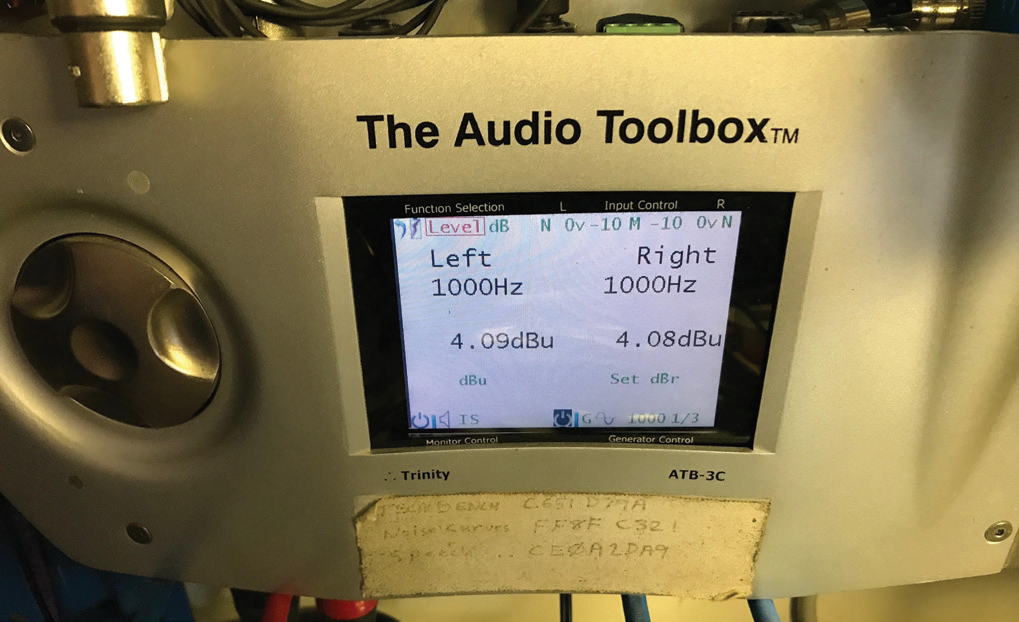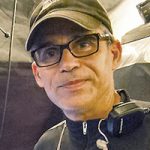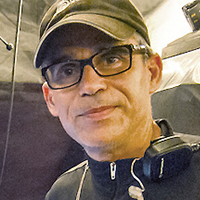Listen To/Download The Audio Version Of This Article:
You know that bit in the first Star Wars movie, where Luke Skywalker is in his spaceship trying to get two pieces of audio equipment talking after he “Jedi’s” it out of the swamp on planet Dagobah, and he hears Obi Wan’s voice telling him to “Use the tones, Luke”?
No? That’s because I just made it up. That said, I feel like in a galaxy that far away and that long ago, it could have happened.
In any case, the point is that when you need to set an audio level between two pieces of gear, it’s best to use an established reference level, sourced from a tone generator (a.k.a., oscillator). Why? Because a reference level is not subjective, and other sources – like a mic that you’re saying “Check! Check!” into, or music tracks – are subjective. This is a particularly important point when there’s more than one engineer involved in a production, and it’s even more important when there are multiple locations involved, regardless of whether the other location is a room down the hall or a studio on the other side of the country.
Using “tones” to check and align levels between two or more pieces of equipment is standard operating procedure in the broadcast world, and it used to be SOP in the recording studio world when tape machines were in regular use, but it’s fallen into disuse of late. In the live sound world this practice is even less common, but here I’ll illustrate a few applications where it’s worth using.
Splitsville
From 1997 through 2001 I was the sound system designer and audio supervisor on a late-night talk show called Open Mike with Mike Bullard that was broadcast on the CTV network here in Canada. For the first few seasons, the system was a rental package that we would re-install each September for a 40-week season. There were four mix positions on the show, which, starting from backstage, were:
• Guest Band Monitors – Modified Soundcraft K2-40 console
• Front Of House – Allen & Heath GL4000-44 (guest bands, traffic*) and an A&H GL2200 (house band mains and IEMs) consoles, linked.
• Music Mix – Neotek Elan-II-32 (guest bands) and a Mackie 32-8 (house band) consoles
• Broadcast Mix – Yamaha PM3500-48 console
* “traffic” is a broadcast term referring to the host and guest mics, announcers, playbacks, etc.
Now, musically, this required a three-way split of the various microphone inputs for the guest bands (Mons, FOH, Music Mix) and a two-way split for the house band (FOH, Music Mix). However, where things got a bit more complex was with the rack of wireless microphone systems as they had to be split to all four mix positions.
While it was rare for a mic to be sent to all four positions at one time, three of the four was common, with the most-used example being the host’s lavalier mic going to the guest band monitor desk (for the “throws” as in, “Here they are with their hit song…”), FOH, and Broadcast Mix (and possibly even Music Mix if the show was being multi-tracked that night). The four-way split was accomplished with a rack of Brooke-Siren Systems (BSS) MSR-604-II active splitters.
This arrangement was in place from the start of season two when the show moved to its new home, the newly renovated studios at the Masonic Temple in downtown Toronto. So, we had four (or even six, depending on routing) different consoles, with different pad and gain settings, four engineers, and from the first time I said “Check, Check!” into the first RF mic channel, at least four different opinions on what that level looked like when it hit the consoles.
As soon as I started hearing on the intercom, “Well, I’m seeing that at around ‘x’ level and if it just came down a bit, I could take my pad out,” immediately followed by, “Well, I’m seeing it at ‘xx’ level and if it just came up a bit…” I knew that it was just going to lead to too much back-and-forth and probably ongoing arguments about levels throughout the entire season. What to do? At the time wireless systems weren’t equipped with internal tone generators**, so I grabbed my audio test set, a Terresonde ATB-1 (a hardware precursor of the popular Audio Tools app by Studio Six Digital), plugged a pair of headphones into it, and routed a 1 KHz tone to the ‘phones. Then I clamped the phones over the end of the first mic and brought the level up until I was seeing nearly full bars on the audio meter on the associated receiver channel. And that was it.
**The internal tone generator is a feature that I pushed for, for years, whenever I was on any industry input panel convened by one of the wireless manufacturers, and happily, that feature is now included in many pro level systems such as Lectrosonics DSQD, Shure Axient Digital, and Sennheiser EM 6000.
All four engineers set their input levels, and I never heard another word about it for the rest of the seasons that I was involved with the show (we would repeat this procedure at each year’s set-up). I should point out that in that instance, I don’t even know what the actual level coming out of the receivers was (in terms of numbers like +4 dBu, 0 dBU, -6 dBu, etc.), I just know that it was a steady tone with the same level going to all four mix positions so the engineers could set up their gain staging accordingly.
Spreading It Around
As another example, in early 2002, I worked on a large corporate event that was held in five cities around North America – Dallas-Fort Worth, Fort Lauderdale, Atlanta, New York, and Toronto. This was one of the first big corporate events after 9/11 and the decision was made to hold it in multiple cities so that the client did not have to risk flying all those employees to one location.
These days, this would take on some iteration of a Zoom call, but back then we were using telephone land lines and interface boxes. It also included a Clear-Com intercom system, which, being all analog at the time, also connected over phone lines through interface boxes like the TW-12B. I remember being very impressed with the intercom in that once we had the phone lines “latched up” between cities, talking on the comms to someone halfway across the country was no different than if they were at, say, FOH and I was backstage.
The audio approach was the usual console at FOH for the PA, with a second desk backstage for inter-city routing. These desks would have a pair of channels (left and right) dedicated to each city. My job was running the backstage console and managing all the telephone line interfaces in Fort Lauderdale. The FOH engineer just mixed it as a regular event, with the distant cities showing up as sources on their console.
On the set-up day, getting the intercom working was, of course, job one. Once we had comms, we could then concentrate on getting the audio signal flowing seamlessly between cities. Eventually, the time came to start “faxing out” (another broadcast term, it means testing) the lines between cities, starting with DFW, which was HQ for this job.
I forget what the source coming from DFW was, but it was either music or video playback. So, when I heard the word “Well…” coming from engineers in at least a couple of different cities (as in “Well, I’m seeing that at…), even though it wasn’t really my place to, I said to all and sundry on the comm, “Wait, wait, stop!”
I then got everyone to turn on the oscillators in their consoles, route it to the two-mix (main) outputs, bring the level up to 0 VU… and then we went around to all five cities in turn and checked their levels (and polarity) to each of the other cities, and we were done in 10 minutes. When it came to running the actual multi-day event, I don’t recall a single conversation regarding levels between cities not being right.
The Right Tool
In my final example, a studio client reached out to me for some help with a popular compressor that he’d just built from a kit. Initially, this consultation was conducted via e-mail and his issue was that “it was working but sounded kinda’ thin.”
Suspecting that one of the balanced connections was “one-legged” (missing either the Pin-2 or Pin-3 connection on an XLR), I asked him if the level was down -6 dB. This went back and forth for long enough that I finally picked up the phone and called him. When I asked, again, if the signal was down -6 dB, I heard him say, “Check! Check! Yeah, it’s probably about that much…”
My response was, “You’ve been troubleshooting this with a microphone this whole time?! Turn on the oscillator in your console, patch it through the compressor and tell me exactly what the output level is.”
This he did, and shortly we established that the level was in fact -6 dB. At this point I told him what connections to double check (he had sent me the schematics) and within a short time he found the suspect connection and the unit was fixed.
So, the lesson here is even if you “know” what your voice sounds like through a particular mic or what your favorite music track sounds like at “x” level, they’re both subjective measurements that, while they may work perfectly well when you’re by yourself, may not do the same when they are being interpreted by another engineer.
Nothing beats knowing that when console “A” is putting out 0 dBu, (or -18 dBFS, or whatever the chosen operating level is) that console “B” has been dialed in to show exactly that same level when it receives a signal from console “A.” In that case, if something does go wrong, it makes it a lot faster and easier to diagnose the issue, an obvious example being if, say, the right channel is showing up -6 dB lower than the left.
Of course, the -6 dB example is based on analog XLR connections being used for all interfacing, which isn’t as common these days. However, I would argue that even when using digital routing options, like Dante or AES, it’s still best practice to use test tones to fax out the system.















